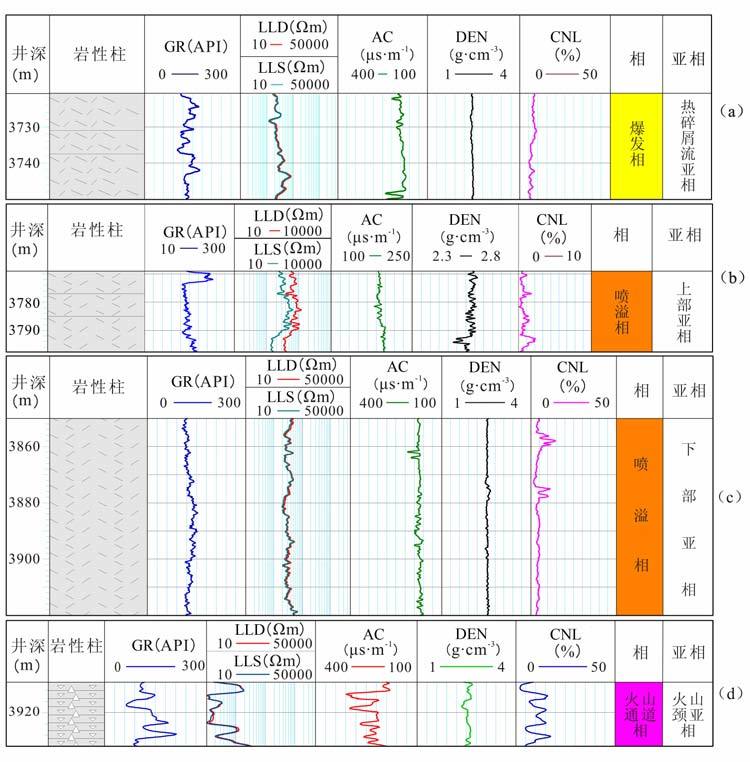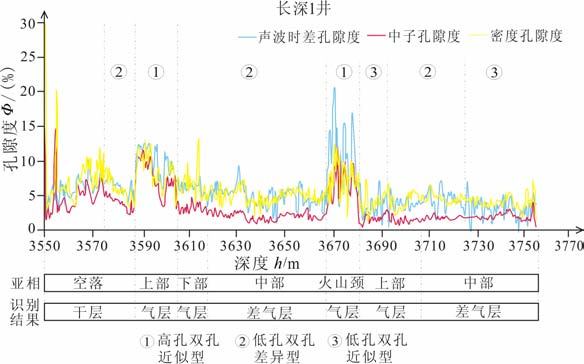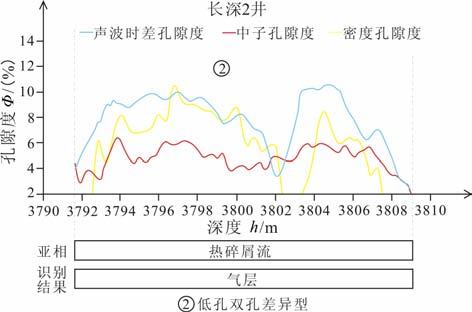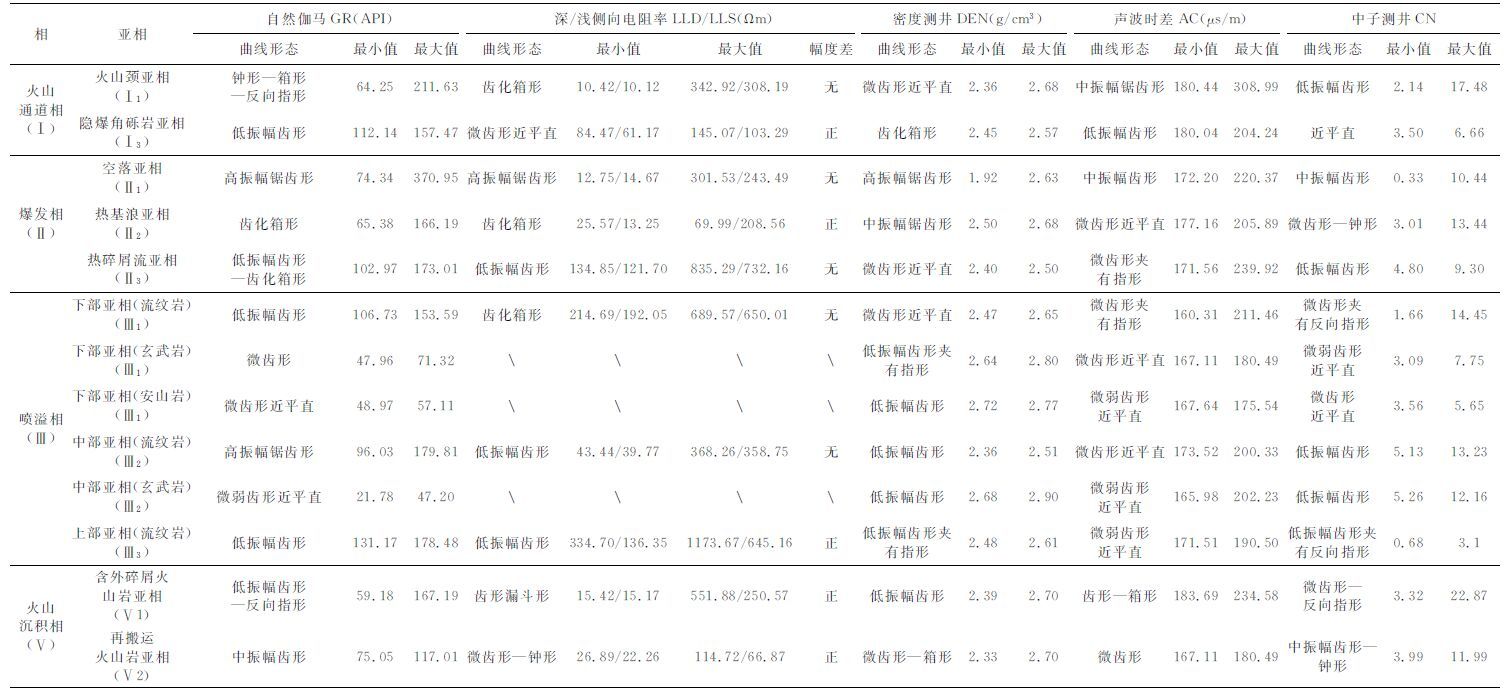2. 煤炭科学研究院总院,唐山 063012
2. China Coal Research Institute, Hebei Tangshan 063012,China
松辽盆地南部长岭断陷是高含油气地区,长深气田就位于松辽盆地南部长岭断陷中部凸起带哈尔金构造,为西倾的北东-南西走向断鼻构造[1].2006年在长岭断陷深层的几口探井中发现了大量的火山岩气藏.而且气藏普遍含CO2,其中长深2 井、长深4井、长深6井营城组火山岩储层中CO2 含量高达98%.长深2井CO2 气分布在营城组三段火山岩储层中,该气藏位于前神字井断裂控制的裂隙式喷发形成的火山口上,控藏断裂前神字井断裂为控陷断裂.同样长深4井和长深6井CO2 气藏也是受控于前神字井断裂形成的CO2 气藏.总之,高含CO2 气藏的分布受火山岩和断层控制明显,且为幔源成因[2~8].而长深1 井的CH4 含量相对比较高.研究区火山岩储层和气体成分的复杂性给气层的识别造成了较大的难度.
利用地震的方法可以识别气层,如同时反演纵波速度与泊松比[9]和频谱分析[10]等.由于受复杂火山岩岩性的影响,测井识别烃类气层和CO2 气层必须克服岩性的影响,而声波-中子重叠受岩性影响较小,这也为区分储层中烃类气层和CO2 气层提供了一种手段[11~14].有些学者针对砂岩储层的几种常用而又比较有效的气层识别方法:孔隙度比值重叠法[15]、孔隙度差比值法[16]、气饱和度法[17]、声波-密度孔隙度差值法[18]和声波-密度孔隙度比值法等[19~24].
由于火山岩亚相是控制火山岩储层有效的关键因素之一,在前人研究成果之上,本文首先通过钻井的岩性和测井资料,分析不同火山岩亚相的测井特征,并建立控制优质储层发育的亚相测井相模式,在亚相约束下,利用中子-密度-声波3种孔隙度重叠图技术定性识别出火山岩气层、差气层、干层和CO2气层.为研究区火山岩气藏的勘探与开发提供参考.
2 松南长岭断陷火山岩亚相的测井特征火山岩的岩性、岩相识别是火山岩油气勘探的基础工作之一,目前国内外的研究方法包括钻井地质、地震预测和测井识别等[25~29].根据研究区的实际特点,本文的火山岩亚相识别采用地质与测井结合的方法.本区火山岩主要见于营城组一段及三段,营一段主要为酸性火山岩类,主要见于长深1井区,营三段主要为中基性火山岩类,主要见于长深2 井区.根据王璞臖(2007)的岩性和岩相分类方案[30, 31],研究区主要岩石类型包括火山角砾岩、凝灰岩、流纹岩、英安岩、安山岩和玄武岩.主要发育四个火山岩相和十二个亚相:爆发相的热碎屑流亚相、热基浪亚相和空落亚相,喷溢相的上部亚相、中部亚相和下部亚相,火山通道相的火山颈亚相和隐爆角砾岩亚相,火山沉积相的含外碎屑火山岩亚相和再搬运火山岩亚相.其中爆发相的热碎屑流亚相、喷溢相的上部亚相和下部亚相、火山通道相的火山颈亚相是本区的优质储层发育相带.根据研究区26口井的地质和测井资料分析,各亚相的测井特征如表 1,在此基础上建立了优质储层发育亚相的测井相模式(见图 1).
|
|
表 1 研究区火山岩亚相分类与测井特征 Table 1 Volcanic subfacies classification and logging characteristics |

|
图 1 爆发相热碎屑流亚相(a);喷溢相上部亚相(b)、喷溢相下部亚相(c)和 火山通道相的火山颈亚相测井模式 Fig. 1 Log facies model of pyroclastic flow subfacies of explosive facies(a) ,upper subfacies of effusive facies(b),lower subfacies of effusive facies(c) ,and diatreme subfacies of volcanic conduit facies (d) |
征及亚相约束下的气层识别目前用于识别油层和气层的方法主要是根据三孔隙度测井,即声波测井、密度测井和中子测井[11~13].相对于水层而言,除了气层的电阻率较高外,气层的声波时差测井值增大,密度测井值减小,中子孔隙度测井值减小,因此,可以根据这些特征来识别气层.本次研究是在火山岩亚相约束下进行的,这样提高了气层的测井识别准确性.
尽管甲烷和二氧化碳都是气态物质,它们在三孔隙度测井曲线显示上具有相似之处,但是甲烷气层和二氧化碳气层在三孔隙度测井曲线显示上存在着一定的差异.在声波时差曲线上非烃类气层和烃类气层没有多大差别,在中子孔隙度测井曲线显示上,烃类气层相对来说是偏大的,但是差异并不明显;烃类气层和二氧化碳气层在密度测井曲线显示上存在着较大的差别.这是因为在相同状态下,二氧化碳的体积密度是甲烷体积密度的三倍多.通常可采用声波时差和密度测井曲线相配合来识别与区分非烃类气层和烃类气层[11~13].
3.1 CS1井含CO2 烃类气层的识别CS1井储层为营一段火山岩,深度为3546~3910.5m,厚度为364.5 m,主要岩性为流纹岩、流纹质晶屑熔结凝灰岩以及流纹质晶屑凝灰岩,发育有喷溢相、爆发相和火山通道相.
通过测井数据的分析处理,绘制了CS1井声波测井、密度测井和中子测井的三孔隙度重叠图(图 2).图中可以看出CS1 井在深度3575~3755 m 井段声波孔隙度大于中子孔隙度,初步识别为可能的气层.我们发现在可能的气层井段声波孔隙度和中子孔隙度的叠合出现3 种类型,分别是高孔双孔近似型(图 2中①)、低孔双孔差异型(图 2中②)和低孔双孔近似型(图 2中③)(孔隙度5%为界).

|
图 2 火山岩亚相约束下CS1井三条孔隙度曲线重叠图识别气层 Fig. 2 Porosity curves of the three overlapping pattern |
对可能的气层井段火山岩进行亚相识别,并标在相应的井段上(图 2).
高孔双孔近似型表明火山岩储层物性较好,声波孔隙度和中子孔隙度均较高(大于5%),两种孔隙度值差值不大.其出现在3587~3606 m 和3668~3680m 两个深度,分别对应上部亚相和火山颈亚相两种有利相带中,判别这两层为气层.
低孔双孔差异型表明火山岩储层孔隙度较低,声波孔隙度和中子孔隙度均较低(小于5%),两种孔隙度值差值较大.其出现在3573~3588m、3618~3668m 和3692~3726 m 三个深度,分别对应下部亚相、上部亚相、中部亚相和空落亚相四种亚相,其中与上部亚相和下部亚相两个有利相带对应的可能气层解释为气层,中部亚相对应的可能气层解释为差气层,而空落亚相对应的可能气层解释为干层.
低孔双孔近似型表明火山岩储层孔隙度较低,声波孔隙度和中子孔隙度均较低(小于5%),两种孔隙度值差值不大.其出现在3680~3692 m 和3726~3755m 深度,对应上部亚相和中部亚相,因此,分别解释为气层和差气层.
最后,利用三孔隙度重叠图来区分烃类气层和CO2 气层,CS1井的可能气层井段声波孔隙度与密度孔隙度差别较小,判别为烃类气层.解释结果与试气结果吻合.
3.2 CS2井CO2 气层的识别CS2井储层为营三段火山岩,深度3788~4245m,有9种岩性:凝灰岩、安山质凝灰岩、玄武岩、晶屑凝灰岩、橄榄辉石玄武岩、流纹岩、角砾岩、安山岩、火山角砾岩,属于喷溢相和爆发相.
通过测井数据的分析处理,绘制了CS2井声波测井、密度测井和中子测井的三孔隙度重叠图(图 3).在深度3792~3808 m 井段声波孔隙度大于中子孔隙度井段,判别为可能的气层.两种孔隙度曲线叠合为低孔双孔差异型(图 3).可能气层对应热碎屑流亚相(图 3),为有利储层相带,进一步判别为气层.CS2井的可能气层井段声波孔隙度与密度孔隙度差别较大(图 3),判别为CO2 气层.解释结果与试气结果吻合.

|
图 3 火山岩亚相约束下CS2井三条孔隙度曲线重叠图识别气层 Fig. 3 Porosity curves of the three overlapping patternrecognition gas zone of CS2 well under volcanic subfacies |
(1) 松辽盆地南部长岭断陷营城组火山岩储层岩相主要为爆发相的热碎屑流亚相、喷溢相的上部亚相、下部亚相和火山通道相的火山颈亚相.通过自然伽马、电阻率、声波时差和中子孔隙度等参数可以识别四种储层亚相.
(2) 火山岩亚相约束下气层识别的方法是:中子-声波孔隙度初步判别可能的气层;然后,依据可能气层的亚相类型,进一步判别气层、差气层或干层;最后再应用三孔隙度重叠法来识别烃类气层与CO2 气层.通过在CS1 井和CS2 井的应用,证实本方法可以提高利用测井资料识别气层的准确度.
本文的火山岩储层亚相和气层的测井识别,只是针对长岭断陷的酸性岩类,也没有应用到全部钻井中,因此,本文的方法还有待进一步完善和检验.
| [1] | 单衍胜, 张林炎. 松辽盆地南部长深气田深层火山岩储集层特征及有利区预测. 石油地质工程 , 2008, 22(5): 33–36. Shan Y S, Zhang L Y. Reservoir characteristics of deep volcanic rocks and prediction of favorable areas in Changshen gas field in the south of Songliao basin. Petroleum Geology Engeering (in Chinese) , 2008, 22(5): 33-36. |
| [2] | 戴金星, 宋岩, 戴春森, 等. 中国东部无机成因气及其气藏形成条件. 北京: 科学出版社, 1995 . Dai J X, Song Y, Dai C S, et al. Abiogenic Gas in Eastern China and Its Formation Conditions of Gas Reservoir (in Chinese). Beijing: Science Press, 1995 . |
| [3] | 戴金星, 石昕, 卫延召, 等. 无机成因油气论和无机成因的气田(藏)概略. 石油学报 , 2001, 22(6): 5–10. Dai J X, Shi X, Wang Y Z, et al. On oil and gas abiogenic and abiogenic gas field (reservoir) briefly. Oil Journal (in Chinese) , 2001, 22(6): 5-10. |
| [4] | 朱岳年. 天然气中非烃组分地球化学研究进展. 地球科学进展 , 1994, 9(4): 50–57. Zhu Y N. Hydrocarbon component of natural gas geochemical study of China-Africa progress. Advance in Earth Sciences (in Chinese) , 1994, 9(4): 50-57. |
| [5] | 关效如. 我国东部高纯二氧化碳成因. 石油实验地质 , 1990, 12(3): 248–258. Guan X R. The causes of high purity carbon dioxide in China's eastern. Experimental Petroleum Geology (in Chinese) , 1990, 12(3): 248-258. |
| [6] | 何家雄, 夏斌, 王志欣, 等. 中国东部及近海陆架盆地不同成因CO2运聚规律与有利富集区预测. 天然气地球科学 , 2005, 16(5): 622–631. He J X, Xia B, Wang Z X, et al. Migration and accumulation and a favorable forecast of different causes CO2 in Eastern China and the offshore shelf basin. Earth Sciences and Natural Gas (in Chinese) , 2005, 16(5): 622-631. |
| [7] | 米敬奎, 张水昌, 陶士振, 等. 松辽盆地南部长岭断陷CO2成因与成藏期研究. 天然气地球科学 , 2008, 19(4): 452–456. Mi J K, Zhang S C, Tao S Z, et al. Genesis and accumulation period of the CO2 in Changling fault depression of Songliao basin, Northeastern China. Natural Gas Geoscience (in Chinese) , 2008, 19(4): 452-456. |
| [8] | Wang P J, Hou Q J, Wang K Y, et al. Discovery and significance of high CH4 primary fluid inclusions in reservoir volcanic rocks of the Songliao Basin, NE China. Acta Geologica Sinica , 2007, 81(1): 113-120. |
| [9] | 姜秀娣, 刘洋, 魏修成, 等. 一种同时反演纵波速度和泊松比的方法. 地球物理学进展 , 2005, 20(2): 314–318. Jiang X D, Liu Y, Wei X C, et al. A P-wave velocity and Poisson ratio nonlinear inversion method. Progress in Geophysics (in Chinese) , 2005, 20(2): 314-318. |
| [10] | 黄中玉, 王于静, 孙显义, 等. 分频技术在气层识别中的应用. 勘探地球物理进展 , 2008, 31(1): 73–79. Huang Z Y, Wang Y J, Sun X Y, et al. Application of frequency division technology in the detection of gas reservoir. Progress in Exploration Geophysics (in Chinese) , 2008, 31(1): 73-79. |
| [11] | 潘保芝, 张丽华, 印长海, 等. 火山岩CO2气层的测井识别与含量预测. 大庆石油地质与开发 , 2009, 28(6): 299–303. Pan B Z, Zhang L H, Yin C H, et al. Identification and content prediction of CO2 in volcanic rocks. Petroleum Geology and Oilfield Development in Daqing (in Chinese) , 2009, 28(6): 299-303. |
| [12] | 李雄炎. 深层火山岩气层测井识别方法研究. 工程地球物理学报 , 2008, 5(3): 337–341. Li X Y. Research on the methods of identifying deep natural gas in volcanic rock. Chinese Journal of Engineering Geophys (in Chinese) , 2008, 5(3): 337-341. |
| [13] | 闫磊, 潘保芝, 陈玉魁, 等. 松辽盆地东岭地区火山岩气层测井识别与综合评价. 物探与化探 , 2008, 132(6): 656–660. Yan L, Pan B Z, Chen Y K, et al. Log recognition and integrated evaluation of volcanic gas-bearing reservoirs in Dongling Area, Songliao Basin. Geophysical & Geochemical Exploration (in Chinese) , 2008, 132(6): 656-660. |
| [14] | 刘中奇, 杜春玲. 非烃类测井识别方法. 测井技术 , 1998, 22(2): 107–110. Liu Z Q, Du C L. Identification of non-hydrocarbon gas zone. Logging Technology (in Chinese) , 1998, 22(2): 107-110. |
| [15] | 李强, 杨斌, 雍自权, 等. 川中合川地区低阻气层测井识别研究. 天然气技术 , 2009, 3(6): 44–46. Li Q, Yang B, Yong Z C, et al. Well-logging identification of low-resistivity gas reservoirs in Hechuan Area, central Sichuan Basin. Natural Gas Technology (in Chinese) , 2009, 3(6): 44-46. |
| [16] | Zhao X L, Liao X W, Chen X. Log identification method in complex sand reservoirs. Mining Sciences and Technology , 2009, 19: 531-536. |
| [17] | Hamada G M. Identification of hydrocarbon movability and typefrom resistivity logs. Petroleum Science and Technology , 2008, 26: 638-648. DOI:10.1080/10916460701204883 |
| [18] | 游利军, 康毅力, 陈一健, 等. 应用屏蔽暂堵技术提高致密砂岩气层测井识别能力. 石油钻采艺 , 2007, 29(1): 113–116. You L J, Kang Y L, Chen Y J, et al. Application of temporary and shielding plugging technology to improve well logging responses for tight sandstone gas reservoir. Oil Drilling & Production Technology (in Chinese) , 2007, 29(1): 113-116. |
| [19] | Wen Z Y, Guo T. A new type of neural network for reservoir identification using geophysical well logs. Mathematical Geology , 2005, 37(3): 243-260. DOI:10.1007/s11004-005-1557-1 |
| [20] | Peng Y J, Tan Y J. Multi-parameter identification and applications in well-logging. Computational Geosciences , 2001, 5: 331-343. DOI:10.1023/A:1014594922928 |
| [21] | Chang H C, Chen H C, Fang J H. Lithology determination from well logs with fuzzy association memory neural network. IEEE Transactions on Geoscience and Remote Sensing , 1997, 35(3): 773-780. DOI:10.1109/36.582000 |
| [22] | Hsieh B Z, Lewis C, Lin Z S. Lithology identification of aquifers from geophysical well logs and fuzzy logic analysis: Shui-Lin Area, Taiwan. Computers & Geosciences , 2005, 31: 263-275. |
| [23] | 赵俊峰, 纪友亮, 陈汉林, 等. 低孔低渗气层测井识别与评价方法研究. 海洋石油 , 2008, 28(3): 96–102. Zhao J F, Ji Y L, Chen H L, et al. Research of identifying and evaluating low-porosity and low-permeability gas-layers in well-logging. Offshore Oil (in Chinese) , 2008, 28(3): 96-102. |
| [24] | 司马立强. 气层测井识别方法及展望. 国外测井技术 , 1998, 13(6): 3–6. Sima L Q. Well log identification method and expectation. Foreign Well Logging Technology (in Chinese) , 1998, 13(6): 3-6. |
| [25] | 谢飞, 常旭, 刘伊克. 火山岩地震屏蔽层的转换波叠前时间偏移成像. 地球物理学报 , 2008, 51(6): 1899–1908. Xie F, Chang X, Liu Y K. Converted-wave pre-stack time migration in volcanic area. Chinese J. Geophysics. (in Chinese) , 2008, 51(6): 1899-1908. |
| [26] | 唐华风, 王璞珺, 姜传金, 等. 松辽盆地火山岩相地震特征及其与控陷断裂的关系. 吉林大学学报(地球科学版) , 2007, 37(1): 73–78. Tang H F, Wang P J, Jiang C J, et al. Seismic characters of volcanic facies and their distribution relation to deep faults in Songliao basin. Journal of Jilin University (Earth Science Edition) (in Chinese) , 2007, 37(1): 73-78. |
| [27] | Bhatt A, Helle H. Determination of facies from well logs using modular neural networks. Pet. Geosci , 2002, 8(3): 217-228. |
| [28] | Coudert L, Frappa M, Arias R. A statistical method for lithofacies identification. J. Appl. Geophys. , 1994, 32: 257-267. |
| [29] | Cuddy S J. Litho-facies and permeability prediction from electrical logs using fuzzy logic. SPE Reservoir Evaluation & Engineering , 2000, 3(4): 319-324. |
| [30] | 王璞珺, 郑常青, 舒萍, 等. 松辽盆地深层火山岩岩性分类方案. 大庆石油地质与开发 , 2007, 26(4): 17–22. Wang P J, Zheng C Q, Shu P, et al. Classification of deep volcanic rocks in Songliao Basin. Petroleum Geology & Oilfield Development in Daqing (in Chinese) , 2007, 26(4): 17-22. |
| [31] | 王璞珺, 迟元林, 刘万洙, 等. 松辽盆地火山岩相:类型、特征和储层意义. 吉林大学学报(地球科学版) , 2003, 33(4): 449–456. Wang P J, Chi Y L, Liu W Z, et al. Volcanic facies of the Songliao basin: classification, characteristics and reservior significance. Journal of Jilin University (Earth Science Edition) (in Chinese) , 2003, 33(4): 449-456. |
 2011, Vol. 54
2011, Vol. 54


